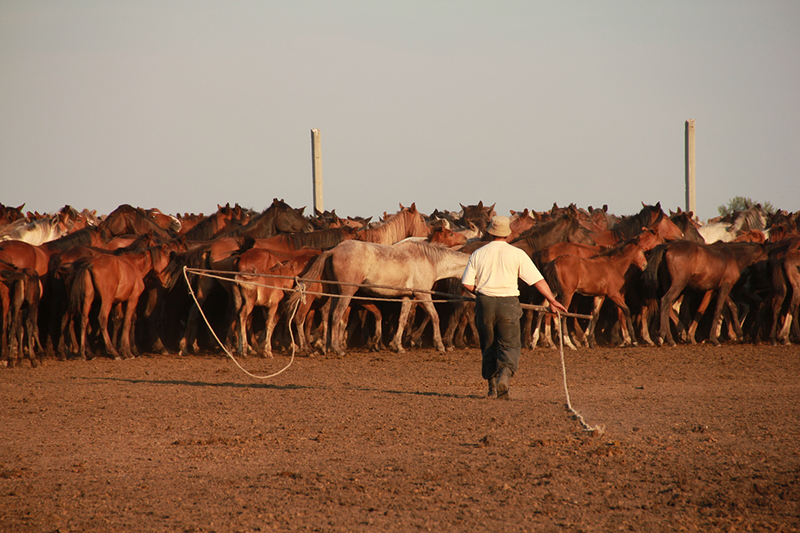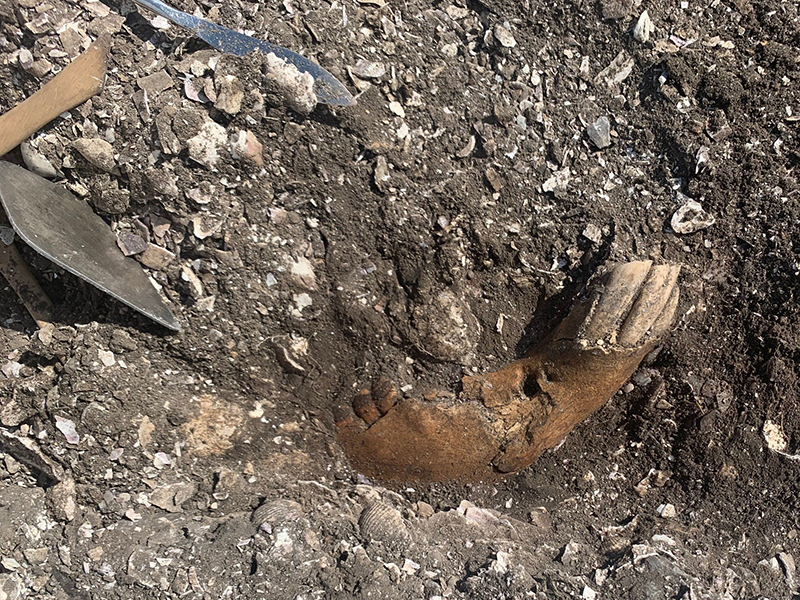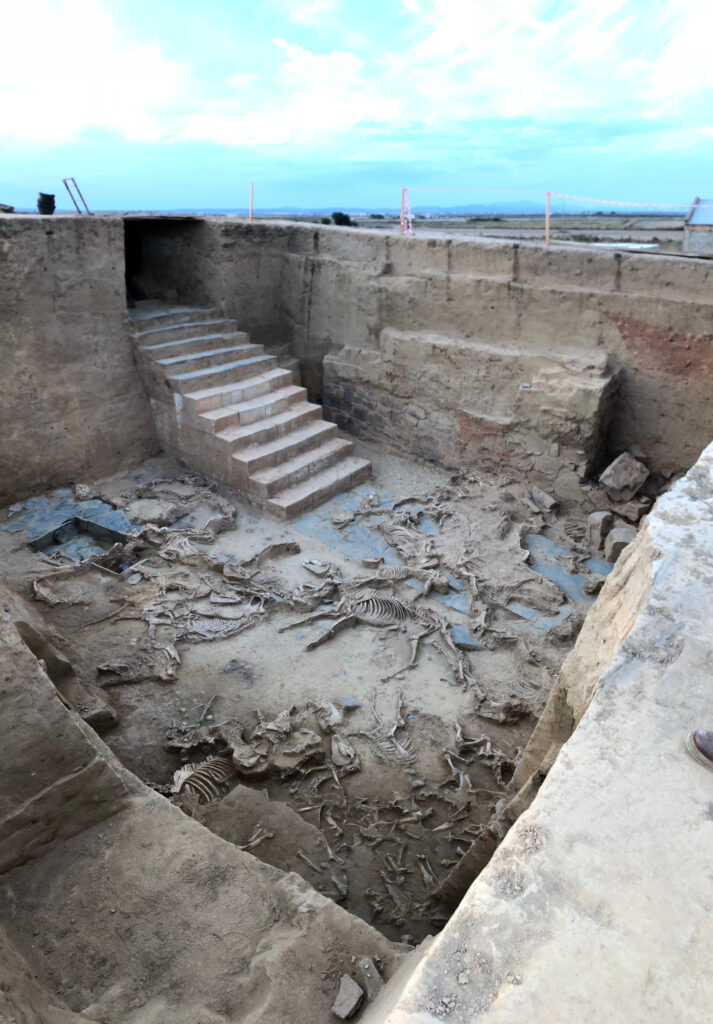Origin of domestic horses finally established

Horses were first domesticated in the Pontic-Caspian steppes, northern Caucasus, before conquering the rest of Eurasia within a few centuries. These are the results of a study led by paleogeneticist Ludovic Orlando, CNRS, who headed an international team including l’Université Toulouse III – Paul Sabatier, the CEA and l’Université d’Évry. Answering a decades-old enigma, the study is published in Nature on 20 October 2021.
By whom and where were modern horses first domesticated? When did they conquer the rest of the world? And how did they supplant the myriad of other types of horses that existed at that time? This long-standing archaeological mystery finally comes to an end thanks to a team of 162 scientists specialising in archaeology, palaeogenetics and linguistics.
A few years ago, Ludovic Orlando’s team looked at the site of Botai, Central Asia, which had provided the oldest archaeological evidence of domestic horses. The DNA results, however, were not compliant: these 5500-year-old horses were not the ancestors of modern domestic horses1. Besides the steppes of Central Asia, all other presumed foci of domestication, such as Anatolia, Siberia and the Iberian Peninsula, had turned out to be false.
“We knew that the time period between 4,000 to 6,000 years ago was critical but no smoking guns could ever be found” says CNRS research professor Orlando.
The scientific team, therefore, decided to extend their study to the whole of Eurasia by analysing the genomes of 273 horses that lived between 50,000 and 200 years BC. This information was sequenced at the Centre for Anthropobiology and Genomics of Toulouse (CNRS/Université Toulouse III – Paul Sabatier) and Genoscope2 (CNRS/CEA/Université d’Évry) before being compared with the genomes of modern domestic horses.
This strategy paid off: although Eurasia was once populated by genetically distinct horse populations, a dramatic change had occurred between 2000 and 2200 BC.
“That was a chance: the horses living in Anatolia, Europe, Central Asia and Siberia used to be genetically quite distinct” notes Dr Pablo Librado, first author of the study.
Then, a single genetic profile, previously confined to the Pontic steppes (North Caucasus)3, began to spread beyond its native region, replacing all the wild horse populations from the Atlantic to Mongolia within a few centuries.
“The genetic data also point to an explosive demography at the time, with no equivalent in the last 100,000 years” adds Orlando. “This is when we took control over the reproduction of the animal and produced them in astronomic numbers.”
But how can this rapid population growth be explained? Interestingly, scientists found two striking differences between the genome of this horse and those of the populations it replaced: one is linked to a more docile behaviour and the second indicates a stronger backbone. The researchers suggest that these characteristics ensured the animals’ success at a time when horse travel was becoming “global”.
The study also reveals that the horse spread throughout Asia at the same time as spoke-wheeled chariots and Indo-Iranian languages. However, the migrations of Indo-European populations, from the steppes to Europe during the third millennium BC4 could not have been based on the horse, as its domestication and diffusion came later. This demonstrates the importance of incorporating the history of animals when studying human migrations and encounters between cultures.

This study was directed by the the Centre for Anthropobiology and Genomics of Toulouse (CNRS/ Université Toulouse III – Paul Sabatier) with help from Genoscope (CNRS/CEA/Université d’Évry). The French laboratories Archéologies et sciences de l’Antiquité (CNRS/Université Paris 1 Panthéon Sorbonne/Université Paris Nanterre/Ministère de la Culture), De la Préhistoire à l’actuel: culture, environnement et anthropologie (CNRS/Université de Bordeaux/Ministère de la Culture) and Archéozoologie, archéobotanique : sociétés, pratiques et environnements (CNRS/MNHN) also contributed, as did 114 other research institutions throughout the world. The study was primarily funded by the European Research Council (Pegasus project) and France Genomique (Bucéphale project).
Some previous results of the Pegasus project:
- Scythian horses shed light on animal domestication, 27 April 2017;
- Unsaddling old theory on origin of horses, 22 February 2018.
Notes
1 Read this press release: Unsaddling old theory on origin of horses, 22 February 2018.
2 Genoscope is a department of CEA-Jacob.
3 The Pontic steppe is the western part of the Eurasian steppe. The home of the modern domestic horse is thought to be in the Don and Volga basins, east of the Dnieper.
4 For example, see this press release: 7,000 years of demographic history in France, 25 May 2020.
Press release from CNRS on the study, published on Nature, concerning the origin of domestic horses.
The new study on the origin of domestic horses, references:
Librado, P., (…), Orlando, Ludovic (2021). “The origins and spread of domestic horses from the Western Eurasian steppes”. Nature, 20/10/2021. DOI: 10.1038/s41586-021-04018-9
————————————————————————————————————————————
Horses were domesticated in the Northern Caucasus steppes and then spread across Asia and Europe
A large group of researchers have conducted the largest genetic study carried out to date, which has made it possible to determine that the horses from which all current domestic horses descend were first domesticated in the steppes north of the Caucasus and, from there, spread to other regions of Asia and Europe.
Researchers from the Milá y Fontanals Institution (IMF) and the Institute of Archaeology (IAM) of the Spanish National Research Council (CSIC), together with scientists from the Museum of Human Evolution (MEH), the Faculty of Veterinary Medicine of the University of Extremadura (UEx), the UCM-ISCIII Joint Centre for Human Evolution and Behaviour in Madrid, the Laboratory of Prehistoric Archaeology of the University Jaume I of Castellón (UJI) and the Faculty of Geological Sciences of the Complutense University of Madrid (UCM)have participated in the largest genetic study carried out to date, which has made it possible to determine that the horses from which all current domestic horses descend were first domesticated in the steppes north of the Caucasus and, from there, spread to other regions of Asia and Europe.
This study brings to an end a long-standing debate about the location and chronology of the earliest documented evidence of domestication of the horses that gave rise to today’s populations, as well as aswering questions about when this domestication process began to spread to other regions of the world, thus replacing other types of horses that existed at the time. The results have been published in the October issue of prestigious international journal Nature.
This conclusion was reached by a team of 114 institutions and 162 researchers specialising in archaeology, palaeogenetics and linguistics, led by Professor Ludovic Orlando, CNRS researcher and principal investigator of the ERC-PEGASUS project, which, together with France Genomique-Projet Bucéphale, financed the research. The study involved sequencing the genomes of 273 remains of horses that inhabited various regions of Eurasia in a chronological arc extending from 50,000 to 200 BC. All the genetic information was sequenced at the Centre for Anthropobiology and Genomics of Toulouse, CAGT (CNRS/University of Toulouse III-Paul Sabatier) and Genoscope (CNRS/CEA/University of Évry), before being compared to the genomes of modern domestic horses. Thanks to the large battery of statistical analyses carried out, it has been possible to establish that between 2,200 and 2,000 BC, a drastic change took place in which the genetic profile existing in the Pontic steppes began to spread beyond its region of origin, thus replacing in a few centuries all wild horse populations from the Atlantic to Mongolia.
According to L. Orlando, “this replacement in the genetic composition of Eurasian populations is associated with significant genomic differences between this new type of horse and the horses of the populations that disappeared. On the one hand, this new type of horse from the steppes of the northern Caucasus had a more docile behaviour and, on the other hand, a more robust constitution in the vertebral skeleton”.
The researchers suggest that these characteristics triggered the successful selection of these animals, at a time when horse travel was becoming widespread in Eurasia.
According to Pablo Librado (CNRS), first author of this research, “this study has also shown that the distribution of this new type of horse in Asia coincides with the appearance of light carts and the spread of Indo-Iranian languages. In contrast, the migration of Indo-European populations from the steppe zone to the heart of Europe during the third millennium BC did not use this new type of horse as a vector for its expansion. This result demonstrates the importance of also incorporating the genetic history of animals when analysing the dimension of human migrations and intercultural contacts”.
The individuals analysed include equids from various sites on the Iberian Peninsula, including Casas del Turuñuelo (Guareña, Badajoz) and Cova Fosca (Alt Maestrat, Castelló).
The Cova Fosca was excavated by Francesc Gusi and Carmen Olaria. According to C. Olaria, professor of Prehistory at the UJI and co-author of this study,
“Cova Fosca has a very rich Holocene archaeozoological record. We were able to identify horse remains in ancient Neolithic levels, a very rare taxon in Iberian sites from this period. This uniqueness allowed us to publish years ago, together with Jaime Lira Garrido and Juan Luis Arsuaga, the first mitochondrial sequences of horses from this site”.
According to J. L. Arsuaga, scientific director of the Museum of Human Evolution, professor of Palaeontology at the UCM, director of the UCM-ISCIII Joint Centre and co-author of this study,
“in Cova Fosca we found a unique mitochondrial lineage exclusive to Iberia that currently appears in very few horses, all of which are Iberian or of Iberian origin. In this new study we aimed to unveil the genomic secrets of the Cova Fosca”.
Building Tartessos and Casas del Turuñuelo

Casas del Turuñuelo is one of the most impressive discoveries in peninsular archaeology in recent years. Its excavations are being carried out under a project directed by the IAM-CSIC and are being co-directed by Esther Rodríguez González and Sebastián Celestino, also researchers at the IAM-CSIC.
According to Esther Rodríguez González, co-author of this new study, “Turuñuelo is an architectural complex from the middle of the first millennium BC belonging to the Tartessos culture where we have found the largest hecatomb documented to date in a site of Mediterranean protohistory. This mass slaughter is notable for the large number of equids that have been differentiated in the courtyard of this site. For this study we selected Equid 4”.According to Sebastián Celestino, also co-author of this research, “a multidisciplinary team of specialists from the humanities and biosciences has been created around Turuñuelo, which is generating a constant exchange of information and ideas, thus offering a great multidisciplinary approach to the study of this site”.
Among the lines of research of “Construyendo Tartessos” [Building Tartessos], the genetic study of these slaughtered equids stands out. Jaime Lira Garrido (UEx/Centro Mixto UCM-ISCIII), who is a co-author of this study, explains that
“this latest work led by Professor Orlando has also allowed us to delve deeper into the evolutionary history of Iberian horses. In a previous study, Orlando and his team discovered that a genomic lineage developed on the Iberian Peninsula that is now extinct and very different from the rest of the ancient and modern Eurasian horse lineages described to date. The evolutionary origin of this lineage and the causes that led to its disappearance are still unknown. However, we have been able to identify in the Neolithic sample from the Cova Fosca the oldest evidence of this extinct lineage and that the Turuñuelo Equid 4 was, nevertheless, a descendant of this new type of horse that was so rapidly distributed throughout the known world some 4.000 years ago”.
This study has been funded mainly by the European Research Council (PEGASUS project) and France Genomique (Bucéphale project).
Press release from Asociación RUVID on the new study on the origin of domestic horses.
————————————————————————————————————————————
Scientists Prove the Northern Caucasus Focus of Horse Domestication for Eurasia
South Ural State University (SUSU) scientists and their foreign colleagues have continued study devoted to the time and place of horse domestication. A research group has established where exactly the focus of domestication is located in Eurasia. The results of the work have been published in the highly rated journal “Nature” (Top 10%).
The identical signs have been found in the genomes of domesticated horses in Eurasia. Specialists have noticed that remains of these animals have a strong spine. Probably, this is the reason for domesticated horses popularity and global spreading of horse travels.
The research group which includes PhD, SUSU professor Andrey Epimakhov has established the Pontic-Caspian steppes, northern Caucasus, is the centre of horse domestication. The process has occurred between 2000 and 2200 BC (the Bronze Age). Horses are distinct i n different presumed foci of domestication such as Anatolia, Siberia and the Iberian Peninsula, but several ages later the common genome has spreaded from the Atlantic to Mongolia within a few centuries.
“Our research group that is led by paleo-geneticist Ludovic Orlando, National Center for Scientific Research (France), has analysed the genomes of 273 horses that lived between 50,000 and 200 years BC. The study has covered the whole of Eurasia to research presumed territories to be considered as primary foci of domestication. However, all of the territories have turned out to be false. For instance, the site of Botai, Central Asia, has provided the oldest archaeological evidence of domestic horses. Nevertheless, the DNA results are not compliant: these 5500-year-old horses are not the ancestors of modern domestic horses. On the contrary, the Ural 4000 years old samples don’t raise doubts in horse exploitation and chariot teams,” Andrey Epimakhov explained.
Research has also demonstrated that the horse spread throughout Asia at the same time as spoke-wheeled chariots and Indo-Iranian languages.
Remind that dental calculus research has helped scientists to determine the time and place of horse domestication. There are dairy diet markers that have been detected in samples found in the Volga region. Milk has been a part of people’s ration since animal domestication.
Press release from the South Ural State University on the new study on the origin of domestic horses.


